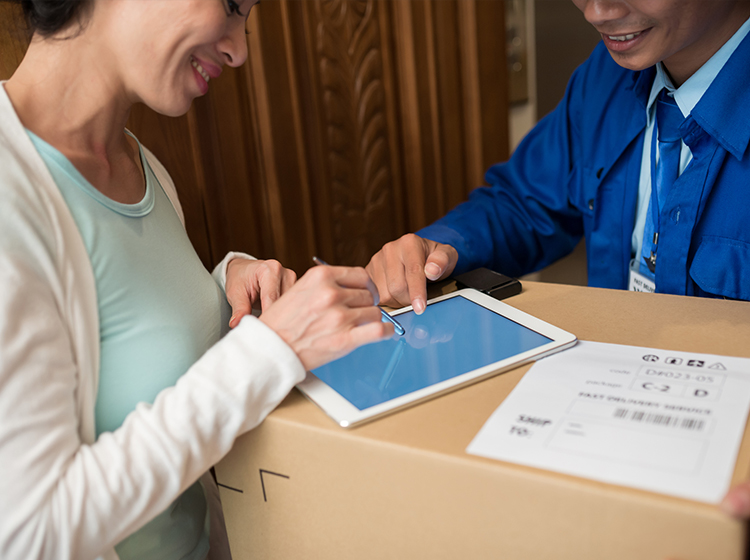The advent of sign-on-glass (SOG) technology, and particularly its use across mobile applications, is bringing much needed efficiencies for freight operators and their customers. And this is only a fraction of the technology's potential.
Keeping up with customer expectations takes constant innovation and, of course, is a key component of the freight transport industry. Fortunately for operators, digital technology has paved the way for a raft of smarter solutions.

How does sign-on-glass technology work?
When an item is delivered, instead of requiring a physical signature from the recipient, which must be scanned or faxed to the customer as confirmation, SOG technology captures their signature digitally. This can save time and paperwork and, more importantly, provides freight customers with instant electronic proof-of-delivery, which can streamline other processes. And now that the technology is available through cost-efficient mobile apps, it is within the reach of companies of all sizes.
The issue of missing goods
A key advantage of digital proof-of-delivery technology is that an electronic signature along with time and place data can provide companies with more watertight insurance should a recipient make a bogus ‘missing goods’ claim.
At least that’s the widely held view. When you get down to the nitty gritty, however, there is some concern over whether electronic signatures have enough legal sway.
Relevant legislation, such as the Electronic Transactions Act 1999 and various corresponding State and Territory Acts, generally states that contracts and transactions are not necessarily invalid if executed electronically.[1] However, an e-signature alone may not be enough to stand up in court.
E-signatures and the law
While progress has been made with current technology and the law, e-signatures are not immune to legal challenge. Under Commonwealth law, there are various criteria that need to be satisfied for an e-signature to be considered evidence of execution of a ‘document’ by a person or entity. For instance, the method of signing should be reliable given the circumstances, it should identify the person signing, and consent must be given by the recipient for the use of e-signatures.
However, even if these requirements are met, it may still be hard to prove the identity of the signer where their e-signature isn’t witnessed by a third party. [2] Unfortunately, this means operators are still open to the possibility of recipients claiming they didn’t receive their goods even where a supplier has a copy of an e-signature on an e-docket.
Digital signature tools which, unlike e-signatures, incorporate identity verification and authentication methods – such as public key cryptography – may provide additional evidence that the individual providing the digital signature is who they say they are digitally, but even these are not foolproof.[3] [4]
With these limitations in mind, it may be useful to choose electronic proof-of-delivery software that offers an archiving function so that you may retrieve data easily, especially in the event of a dispute.[5]
Safety and productivity
Sign-on-glass technology also has positive implications for safety issues around the delivery of dangerous goods, says Felix Ohle, Transport Business Manager at Viva Energy.
"In the future we expect to integrate the SOG technology with our Vendor Managed Inventory (VMI) technology, meaning that manual work required at the point of delivery of dangerous goods will be eliminated… Through the technology we are also hoping to get real-time feedback on distribution movements, meaning we can plan more precisely around traffic to optimise interaction of our dangerous goods deliveries with the public."
Additionally, by shifting higher proportions of the delivery process onto the SOG platform and thereby reducing the need for manual work, there is the opportunity to reduce customer site contact time, meaning you can get more use out of distribution assets.
More than just a new technology
To tap into additional benefits, software can easily be integrated into existing transport management systems. Real-time access to signatures enables customers to generate invoices within minutes of a delivery being completed and keeps invoice discrepancies to a minimum, which helps freight operators improve cash flow and run their businesses more efficiently.
Paul Bell, Project Manager at Viva Energy, says the technology can be leveraged even further.
"We intend to use the devices for more and more functions in cab, rather than just pure proof of delivery. Case in point: our next step is to send the latest DIP information to the tablet. This allows the driver to confirm capacity, drop the load and again speed up time on site. This has a direct benefit for Viva Energy, our customers and our transport partners."
In fact, Felix Ohle says SOG should be considered a way of doing business, not a just new technology.
"It needs to become intrinsic to what we do and how we think and we need to make it part of our daily routine and habits."
[1] Maddocks website, ‘E-signatures, enforceable? That is the question’, accessed 25 October 2016
[2] As above.
[3] As above.
[4] FindLaw Australia website, ‘Electronic signatures and their legal validity in Australia’, accessed 25 October 2016.
[5] As above.
Interested in Viva Energy's products and services?
Find out more here